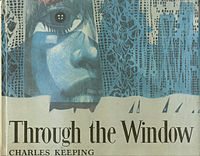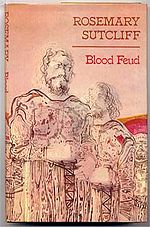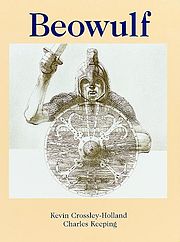- Charles Keeping
-
Charles Keeping Born 22 September 1924
Lambeth, London, EnglandDied 16 May 1988 (aged 63)
London, EnglandOccupation illustrator, children's author, lithographer Spouse Renate Meyer Charles William James Keeping (22 September 1924 - 16 May 1988) was a British illustrator, children's book author and lithographer. He first came to prominence with his illustrations for Rosemary Sutcliff's historical novels for children, and he created more than twenty picture books. He won the Kate Greenaway Medal for outstanding work in children's illustration twice: for Charley, Charlotte and the Golden Canary in 1967, and for an illustrated edition of Alfred Noyes's poem The Highwayman in 1981. He illustrated The God Beneath the Sea, by Leon Garfield and Edward Blishen, which won the Carnegie Medal for children's literature in 1970. He also illustrated the complete works of Charles Dickens for the Folio Society.
His lithographs have been exhibited in London, Italy, Austria and the U.S.A., including at the International Exhibition of Lithography in Cincinnati in 1958. He has prints in many collections, including at the Victoria and Albert Museum.
Contents
Early life
Charles Keeping was born and grew up in Lambeth, London, in a terraced house that housed three generations. He lived in an inner city environment of street markets and working horses that would inform his work his entire life. Charles and his elder sister, Grace, drew and made up stories from an early age, on surplus newsstand placards brought home by their father, Charles Keeping senior, who distributed newspapers to shops and newsstands in the area and boxed under the name Charlie Clarke.
Young Charles was interested in little but drawing and horses, and did poorly at school. He left at 14. The Second World War broke out the following year, and when he turned 18 in 1942 he was called up and joined the Royal Navy as a wireless operator. He returned to civvy street in 1946 with a profound depression and a belief that a head wound he had sustained had disfigured him on the inside as well as (temporarily) on the outside, and would cause him to turn evil like Dr Jekyll becoming Mr Hyde. He received treatment, was institutionalised for a time, and made a full recovery, but perhaps his sympathetic visual treatments of Frankenstein's monster and Grendel, the monster from Beowulf, owe something to this period of his life.
He applied for a grant to study art at the Regent Street Polytechnic, but for several years was turned down, so he read meters for a gas company during the day and took life drawing classes in the evening. He also worked as a life model, and on one such occasion in 1949 his demonstration of the functions of the muscles of the back attracted the eye of a student called Renate Meyer, who went on to marry him in 1952.
Keeping did get into the Regent Street Polytechnic, where he was taught by well-known illustrators Nigel Lambourne and Stuart Tresilian. He took the two year Intermediate Examination in six months before specialising in illustration and lithography.
Published work
His first published work was a comic strip in a newspaper, the Daily Herald, which he drew for four years, beginning in 1952. He didn't much enjoy it, not seeing himself as a cartoonist, but despite this he also drew cartoons for the Jewish Chronicle, was political cartoonist for the Middle Eastern Review for a time, and later contributed to Punch magazine.
His first book was a humorous health-promotion book called Why Die of Heart Disease? in 1953, and he illustrated a number of educational textbooks, but his breakthrough came in 1957 when he illustrated Rosemary Sutcliff's historical children's novel The Silver Branch, which he would later refer to as his "first book". His drawings were vigorous and played with the conventions of size and placement within the text, and he would go on to illustrate many more children's novels by Sutcliff, Henry Treece, Charles Kingsley, Alan Garner, Geoffrey Trease, Charles Causley, Kevin Crossley-Holland and many others. Leon Garfield and Edward Blishen's retelling of Greek myths, The God Beneath the Sea, which Keeping illustrated in 1970, won the Carnegie Medal for that year.
He also worked on adult novels, including editions of H. Rider Haggard's King Solomon's Mines and Wilkie Collins's The Moonstone. In 1964 he began an association with the Folio Society with an edition of Emily Brontë's Wuthering Heights. He made no secret that he didn't like the book, but nonethess produced twenty-two two-colour lithographs for a publisher who only wanted, and was only prepared to pay for, twelve. The lithographs were sweeping, expressionistic and emotionally charged. He took a similar approach for Erich Maria Remarque's All Quiet on the Western Front, Horace Walpole's The Castle of Otranto, Victor Hugo's Les Misérables and others.
In 1966 he created his first picture books, Black Dolly and Sean and the Carthorse, both about mistreated working horses. He followed these with the stunning Charley, Charlotte and the Golden Canary in 1967. A modern fairy tale about two children who grow up in the same street, are separated when one family moves to a new tower block, and are reunited thanks to a pet canary, Charley depicts the gradual disappearance of the London of Keeping’s childhood, a theme he would return to regularly. The full colour illustrations are excitingly messy and spontaneous, using intense colour, sponge texturing and wax resist, and won Keeping his first Kate Greenaway Medal.
Keeping created 15 full colour picture books for Oxford University Press, and several for other publishers. Joseph's Yard (1969) and Through the Window (1970), two of his finest, were also produced as short films for the BBC's "Storyline" programme. Through the Window in particular showcases many of Keeping's techniques and themes. Told through the eyes of a small boy watching events in the street outside from his bedroom window, the illustrations are full of intense evening light and colour, movement, and even, when a horse-drawn dray rattles across a double-page spread, virtual sound. Other picture books include Richard (1973), about a day in the life of a police horse; Wasteground Circus (1975), on the transient but magical effect on two young boys of the circus coming to town; and Willie's Fire Engine (1980), a romantic, dreamlike tale of a young boy in Edinburgh's dream of being a firefighter.
In 1975 Keeping produced perhaps his most personal work, Cockney Ding Dong, a lavish 190-page volume collecting and illustrating the traditional songs of the family singalongs of his childhood. A record of some the songs was also released, featuring the voices of members of Keeping's family. Charles himself sings "They're Moving Father's Grave to Build a Sewer!"
Beginning in 1978 with The Pickwick Papers, Keeping took on the mammoth task of illustrating the complete works of Charles Dickens for the Folio Society. His knowledge of the vanishing world of industrial London made him the perfect man for the job. The books were originally to be produced by letterpress printing, meaning the illustrations must be pure line drawings with no tones or washes. When they came to be published more modern printing techniques were used which would have allowed Keeping a full range of tones, but he had started with line drawings, so he used the same technique for the entire series, illustrating two books a year until he completed the task with Martin Chuzzlewit in 1988.
Oxford University Press created a new format for Keeping - the black and white picture book for older children. Keeping created four books in this format: The Highwayman (1981), illustrating the poem by Alfred Noyes in gruesome detail, for which he won his second Kate Greenaway Medal; Beowulf (1982), adapted from the Anglo-Saxon epic by Kevin Crossley-Holland, in which the illustrations subverted the text with a certain sympathy for the monster; The Wedding Ghost (1985), an original story by Leon Garfield; and The Lady of Shalott (1986), the well known Arthurian poem by Alfred, Lord Tennyson, all illustrated in evocative line and wash. The influence of Swedish illustrator John Bauer can most clearly be seen on Beowulf.
Keeping continued to produce colour picture books from time to time, including Sammy Streetsinger (1984), about a subway busker's rise to fame as a pop star and subsequent return to happy obscurity, and his final book, Adam and Paradise Island, another story of the changing landscape of London, which was published posthumously in 1989.
Charles Keeping died of a brain tumour on 16 May 1988. His widow, Renate Meyer, runs the Keeping Gallery, displaying his and her own work.
His biographer has commented,
“ His formidable originality within the picture-book convention may not have been altogether apparent to Keeping himself, which is both a strength and a weakness: the strength that he could communicate with unrivalled emotional intensity - but possibly only with one child in twenty; the concomitant weakness is that there was not a lot he could do to broaden this minority appeal and ensure that his books remained in print over longer periods. ” — :Douglas Martin (1993), Charles Keeping: an illustrator's lifeAwards
- Kate Greenaway Medal 1967 for Charley, Charlotte and the Golden Canary
- Carnegie Medal 1970 for The God Beneath the Sea (written by Edward Blishen and Leon Garfield)
- Francis Williams Award for Illustration 1972 for Tinker Tailor: Folk Song Tales
- Francis Williams Award for Illustration 1977 for The Wildman (written by Kevin Crossley-Holland)
- Kate Greenaway Medal 1981 for The Highwayman (written by Alfred Noyes)
- Kurt Maschler Award 1987 for Jack the Treacle Eater (written by Charles Causley)
- W H Smith Illustration Award 1988 for Charles Keeping's Classic Tales of the Macabre
External links
- The Keeping Gallery - Selected pictures by Charles Keeping.
- London Borough of Bromley have erected a blue plaque at Keeping's former home
- Frankenstein illustrations by Charles Keeping
- Two lithographs by Charles Keeping
- Extract from Elidor by Alan Garner, including illustrations by Keeping
- Charles Keeping on artnet
- "Poles for Dinner": Charles Keeping illustration
References
- Douglas Martin (1989), The Telling Line: Essays on Fifteen Contemporary Book Illustrators, Julia MacRae Books
- Douglas Martin (1993), Charles Keeping: an illustrator's life, Julia MacRae Books
Categories:- 1924 births
- 1988 deaths
- Children's book illustrators
- British illustrators
- English children's writers
Wikimedia Foundation. 2010.





